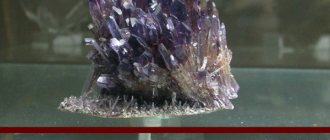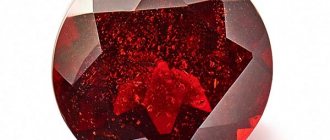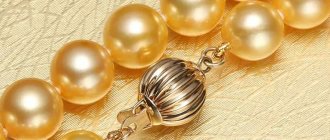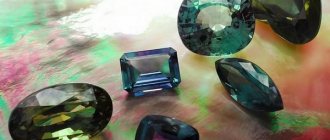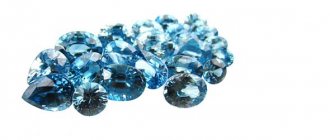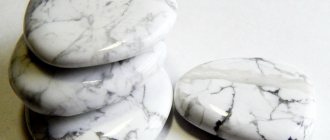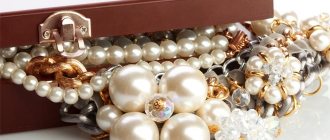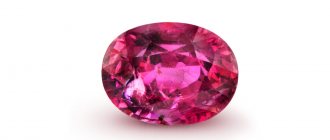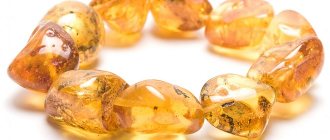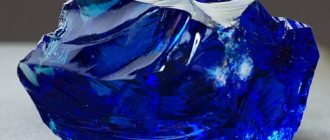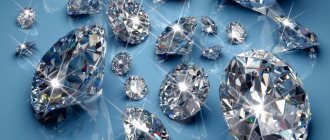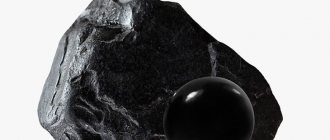This valuable stone has a huge number of colors and shades. The most common color is honey, or sunny. This is usually the color of the Baltic species of this fossil. However, there are a huge variety of shades of the mineral. Most often these are all shades of yellow, from the palest to dark brown and even black. There are also rarer tones. For example, cherry and green amber are extremely rare, but blue amber is the rarest - only 0.2% of the total production. A very beautiful stone is mined in Sicily; it has a bright, fiery hue. Color can vary greatly depending on the type of wood and inclusions of air bubbles. Certain minerals present nearby can also give the fossil resin different shades.
Types of Baltic amber
The most common type of amber is succinite. It is the most popular color - yellow. The stone's name comes from Pinus succinieferra, a prehistoric pine tree that once grew along the Baltic Sea coast.
Gedanite is related to succinite in its origin; both species are derived from the resin of the same tree species. The only difference is the composition of the resin and the conditions under which it hardened. While succinite was fossilized and exposed to oxygen, gedanite hardened due to weathering. Succinic acid is practically not contained in gedanite, and its color is not yellow or honey, but earthy and dark.
Gedanite is sometimes called “rotten amber”; its extraction accounts for only 2% of the total volume. It is interesting that the name of this type of mineral was given by the city, which is now called Gdansk, where gedanite deposits are concentrated.
Stanthienite is the same famous black amber , so popular in the 19th century as a mourning decoration. This is one of the rarest varieties of this fossil. Black amber is very difficult to process due to its fragility, and modern mining methods only destroy it. Black amber does not withstand the pressure of powerful jets of water, which are used to erode the earth when extracting the stone.
Glessite is a featureless form of succinite. It is soft, has a dirty color and is not used either in jewelry or in interior decoration.
Other types of amber
Blue amber is the rarest and hardest type of this mineral. This incredibly beautiful stone is found only in the Dominican Republic, Mexico and Nicaragua, everything else is fake. It is very difficult to process, so the cost of the processed mineral is very high. The depth of color depends on the lighting - in the dark the stone takes on a deep blue color. Due to the admixture of volcanic ash, the stone becomes phosphorescent in the dark. It’s interesting that when held up to light, blue amber appears yellow.
After blue, green amber is the second rarest on the planet. It is found naturally only in the Dominican Republic. The history of its mining began back in the time of Columbus, when green amber was discovered on the island of La Hispaniola. This stone is mined in very deep mines, still using the simplest tools. Green amber is often found in the brown coal from which it is mined. The cheapest stone is mined in the Sabana and Bayaguana mines; it is quite soft and requires additional processing. The best green amber is mined only in the La Cordillera mine.
Red amber is called “dragon’s blood” for its cherry hue. No one knows exactly how it acquired this color, but it is assumed that most likely, the resin of the tree was originally cherry in color. Paler pink amber is also often found. Red stones, as a rule, are found not one at a time, but in entire deposits. The fiery mineral is mined in Ukraine near Lvov, as well as in Sicily, Japan, Burma and Australia.
Fake or original - what material is used
Being a unique stone, amber is often counterfeited; a variety of compositions are used as materials for imitations:
- dug;
- cowries;
- glass;
- plastics
Unlike amber, copal melts faster and emits a rather specific smell. Since copal is formed from the resin of southern trees, it has a more viscous structure.
Cowrie resin is almost never used by jewelers, but is actively used in the manufacture of furniture. It is most similar to amber, but still not as hard as natural stone.
Epoxy resin is a plastic substance that is resistant to elevated temperatures. It has a rather pungent odor, which is noticeable even with slight heating.
The glass has crystal transparency and uniform color. Resistant to minor damage, heavy, the weight of a glass object is greater than the weight of a natural stone product.
The plastic likeness of amber has almost no weight and is created from various synthetic materials. Although fakes are made quite well, it is not difficult to find differences between them and the original. Unlike natural stone, a plastic product does not have foreign particles inside it.
Varieties, colors
The usual golden-hued stone is just one of the varieties.
In fact, there is a classification that helps determine the type:
Shrawfit
Stanthienite
Kranzit
Kiscellite
Gedanite
Glessite
Bokkerit
| Name | Properties |
| Shrawfit | Red, sometimes yellowish-red |
| Succinite | The most common, widely used in jewelry. Contains a high percentage of succinic acid. Brown in color with a yellowish core. Divided by:
|
| Stanthienite | Stones with increased fragility and black-brown color, opaque |
| Kranzit | Mineral in an immature state |
| Kiscellite | Has yellowish, olive and green colors |
| Gedanite | Dark yellow, almost brown, cannot be processed due to brittleness (reason: low oxygen) |
| Glessite | The mineral has practically no impurities, brown in color, opaque |
| Bokkerit | Also opaque, the densest color is reddish-brown. |
There is also Dominican blue amber, which when burned does not emit a pine aroma, but has a pleasant floral scent, thanks to the carob resin.
Caribbean amber refracts incident infrared rays in a special way and is characterized by a bluish glow. These stones are considered the most valuable.
Stones that contain insects or plants are also very expensive. Such fragments are called inclusions. They make the stone original and unique.
How to distinguish natural amber from a fake - important rules
Natural stone is always different from artificial material, no matter how similar in appearance they may be. For example, the strength of a natural mineral is always less than that of its fakes; amber is capable of conducting heat, while glass does not have this function. All this testifies to the individual properties of this stone. How to distinguish natural from artificial amber - several important rules.
The first step is to carefully inspect the stone. The unique structure of amber is its face. Uneven texture, small particles in the composition, scratches, non-uniform color - all this indicates the natural origin of the mineral. While glass products have a greater ability to conduct light, plastic ones cope with this function much worse.
The presence of air bubbles, namely their shape, is of great importance in determining the authenticity of a stone. Round-shaped bubbles are found in natural stones, but in fakes they have an oval shape, which indicates that the material was subjected to rapid pressing.
An important aspect of the uniqueness of amber is its smell, which becomes more intense as the temperature rises. The stone begins to smell like a pleasant pine aroma with notes of cloves. In addition, the mineral has an electrostatic property - the ability to attract hairs and pieces of paper after active friction. A plastic product, in turn, is not so intensely electrified.
A lamp with ultraviolet radiation will help you determine whether the stone in front of you is natural or fake. The bone type of amber (the densest in color) will highlight a whitish color with a hint of heaven. Light blue will have translucent stones. And minerals with a purer texture will reflect light blue. All these methods are useful for accurately determining the authenticity of a stone.
Interesting facts about the mineral
The opinion that amber is a crystalline substance is erroneous. It is a compound of organic acids, the impurities of which are iron, silicon, aluminum, sulfur and nitrogen.
Mantis in amber
Most of the minerals found in the depths of our planet are about 90 million years old. But there are also truly unique ancient specimens. So, in 2009, a fragment 320 million years old was found in Illinois.
The oldest amber is 320 million years old
The stone is credited with healing properties. Let's list just a few of them. When in contact with the body, it is able to cleanse the body of toxins, as well as give the carotid arteries an energy impulse. Many people wear amber jewelry not so much for a decorative effect, but to normalize the function of the thyroid gland and prevent asthma attacks.
Amber jewelry
Each of the giants presented in the ranking is a real rarity. This is confirmed by the fact that to count all amber stones whose weight exceeds 5 kilograms, the fingers of two palms are enough.
Specific properties of amber
Based on color density, amber is divided into: bone amber, which is not of particular value and is often sent for processing, translucent and transparent.
The mineral is light in weight and dense, susceptible to melting and minor damage due to its fragile structure. When burned, it emits a characteristic pine smell mixed with cloves.
Air in the structure of the stone
The natural texture of natural stone contains many air bubbles. There are almost none of them in artificial fakes. There is an opinion that the multiple presence of air masses and inclusions indicates that the stone is not original.
Weight
Amber has a relatively light weight; if you compare it with other materials, then, for example, a plastic product will be lighter, and a glass product will be heavier than natural stone. However, there is such a type of amber as foam, its name speaks for itself; its structure is porous, which determines its low weight.
Inclusions
Another distinctive feature indicating the naturalness of amber is the presence of inclusions in the body of the stone - various insects, plant fragments, seeds, small grains of sand. Anything foreign that gets into the resin during its hardening is called inclusions. When creating an artificial mineral, they can also be placed in it.
The difference at first glance is not particularly noticeable, however, the natural arrangement of inclusions differs from the artificially created one. In natural amber, the arrangement of foreign particles is quite chaotic; when insects get into the resin, they freeze in motion. In a fake stone, everything is laid out in a more orderly manner.
Where are the gem storages?
The largest deposits of amber are located in the Baltic region in places where mainly coniferous forests were located during the Paleogene period. Baltic amber consists of 97% resin produced by the pine species Pinus sussinifera.
Amber deposits
The formation of fossilized resin of ancient trees was facilitated by a sharp critical change in the flora of our planet. A significant increase in temperature and climate humidification provoked massive growth of deciduous trees and abundant resin flow of conifers. As it oxidized with oxygen, the resin became covered with a thick crust and, in this form, already accumulated in the soil of the “amber forest.”
Amber from the Baltic Sea
More than 105 tons of the mineral were mined on the Baltic Sea coast. For this reason, it is often called the gold of the Baltic. The peculiarity of Baltic gems is that they are among the soft stones that are easy to scratch even with a knife.
Blue amber from the Dominican Republic
There are no less rich deposits of amber in the Dominican Republic. In its vastness, amber stones of blue shades are most often found. They are the hardest among analogues. Therefore, not every master is able to process them. The main advantage of such stones is their ability to phosphoresce, which is very important when using them to create jewelry.
Amber with a 10 cm lizard
Deposits in the states of Mexico and Nicaragua are valuable because when mining on these lands, inclusions are often encountered - plants and parts of mammals “stuck” in the resin.
Methods for verifying the authenticity of amber
Saline solution
In order to determine the authenticity of a mineral, you need to use a saline solution, which will require half a liter of water and 300 grams of rock salt. The test sample must be placed in this solution. If the stone remains on the surface of the water, then we have the original; the fake made of glass or epoxy resin will immediately sink; only small fragments of the plastic fake may remain at the top.
Ultraviolet
An ultraviolet lamp will help determine whether the amber in front of us is natural or not. A natural gem under such a lamp will emit a mixture of heavenly and emerald tints, while a fake stone will be illuminated with a golden hue.
Scratch test
To check the authenticity of the stone, you need to use a sharp object. It is enough to pass it over the mineral, pressing lightly, and evaluate the result. There will be no traces or scratches on a glass product, the paint on a plastic fake will be damaged, a deep mark will form on copal, and natural amber will turn into crumbs as the sharp object moves.
Electrostatic test
Natural amber has the physical property of accumulating an electrical charge. By rubbing the mineral against a small piece of fabric, you can achieve static tension, in which small fragments will stick to the gem: fluff, hair, lint, threads.
How to check the authenticity of amber - aroma
Another way to verify the authenticity of a stone is based on smell. Using a sharp object, which must first be heated, it is necessary to move it along the back wall of the object being examined. There will be no smell from a glass product, an unpleasant chemical odor from plastic, rosin from epoxy resin, and a natural gem will smell like pine needles.
Unusual verification methods
If you find amber while walking along the beach, you can check it by biting it with your teeth. A dent will not form on stone and glass; a mark will remain on the resin of conifers.
Place a couple of drops of oil on the natural stone, wait a little and wipe with a cloth. If the gem feels sticky and is not as smooth as it was originally, then it is a genuine stone. Nothing like this would have happened with imitation stone.
Stone Jewelry
Amber is made from:
- earrings;
- bracelets;
- pendants;
- brooches;
- cufflinks;
- pendants.
How to wear jewelry depending on age and appearance:
- yellow gem suits everyone;
- green color suits platinum blondes or red-haired girls;
- silver frame is the best choice for teenagers or young adults; gold – for middle-aged people;
- The mineral in dark tones looks good on older men and women; it will add several years to young girls.
Examples of successful combinations with which you can wear amber:
- bright summer sundress and bracelet;
- long beige dress and earrings;
- light suit and brooch.
Caring for stone and products
Amber is fragile and requires careful handling. Rules of care:
- store separately from other jewelry;
- do not throw the product;
- avoid contact with perfumes, soaps, creams to avoid stains;
- do not leave in the sun - the gem will darken;
- Avoid sudden temperature fluctuations - the stone will crack.
The stone gets dirty a little, and there is rarely a need for cleaning.
To clean, paraffin and tooth powder are mixed in equal proportions, and the resulting mixture is evenly coated on the stone. When dry, remove with a dry cloth or paper napkin.
In addition to the theme of amber jewelry, video:
What is used to make natural amber?
Resin
The age of amber is enormous; it was created over centuries. At its core, it is a fossilized resin, trying to create an imitation, using a similar material as a basis. The stone is rich in color and various particles. Its texture is uneven, the smell disappears over time, but when heated it can appear again. A fake stone is smoother, more even, and has no flaws.
dug
Copal is also a conifer resin, indicating that it is related to amber. Significant difference between stones in age. If copal is quite young, about 100,000 years old, then the age of amber is very significant, it was created over millions of years.
In cases where it is very difficult to find the differences between the original and the fake, they resort to rather drastic measures - the samples under study are subjected to melting. This method of testing can cause damage to the stone, since it is destroyed during melting.
Cowrie
To make a replica of amber, a resin derived from a tree species called kauri is very often used. It is enough to carry out proper processing of this resin and it will be difficult to distinguish the original from the fake. In appearance they will be very similar. The main difference is strength. Since cowrie is much inferior in strength to amber, it is practically not used for the production of jewelry.
Faturan
This name is given to a special composition that includes natural resins and residues from amber processing. The result was a mineral similar to genuine amber, but not fully inheriting its individual properties.
Faturan was a fairly expensive mineral. Many dreamed of having it in their collection. Crimson-yellow, without a glossy sheen, imprinted with intricate monograms, it attracted everyone's attention. Specimens containing gold leaf were especially prized.
According to scientists' research, the mixture for faturan was invented back in the eighteenth century. The exact manufacturing recipe has not survived to this day, which led to the fact that craftsmen began to make fakes. One of the German companies began this process on a particularly large scale; bakelite was used as the main component. These counterfeit samples were produced almost until the mid-twentieth century. They had their significance for collectors, but faturan still cost an order of magnitude more. It happened that faturan was more expensive than natural amber.
Plastic
Due to the increase in pricing for natural stones and the decline in people's quality of life, the invention of fake amber made of plastic has begun to progress. Such imitations began to appear on a large scale during the First World War, and they appeared back in the eighteenth century.
Products made of plastic are lightweight; their weight is much smaller than the original. The difference is also in the structure; for plastic products it is more uniform. The color is overly saturated and dense.
Glass
When glass masters improved their skills, fake amber began to be produced from this material. It could be given any desired shape. And the use of various natural and chemical dyes gave the product a variety of colors. Glass has certain physical properties by which it can be distinguished from a real mineral. This material is highly shiny, has significant weight, and has a melting point higher than that of amber.
Pressed gem
Pressed amber is not fake in the truest sense of the word, although it is produced from small pieces and waste of amber, it is still a natural mineral. In terms of its qualities, pressed amber is inferior to natural stone; there are no particular differences in properties and composition. They are not uniform in color, there are a large number of small inclusions, and are quite cloudy.
Bernit
The composition of polyester resins and amber waste is called burnite. The amount of amber in this composition is small, about five percent. Burnite stones are quite rounded, aligned, have approximately the same size, are quite large, and their price is less than that of amber. Craftsmen have reached a high level of manufacturing, learned how to make brightly colored gems and convey the texture of the stone. In this case, the mineral is processed even inside, thereby achieving an internal picture with ornate patterns.
Silver "Burmese" leader
“Burmese” amber is also a real giant. The age of the treasure dates back to 97 million years. Found in the upper part of Burma in mining conditions, the “sun” stone weighed 15.25 kg. It had a brownish-yellow color.
Amber from Burma, 15.25 kg
After careful study, they decided to present the stone to the world. That is why today it is a decoration of the Natural History Museum in London. On display in the same museum are other, smaller specimens with various types of inclusions.
